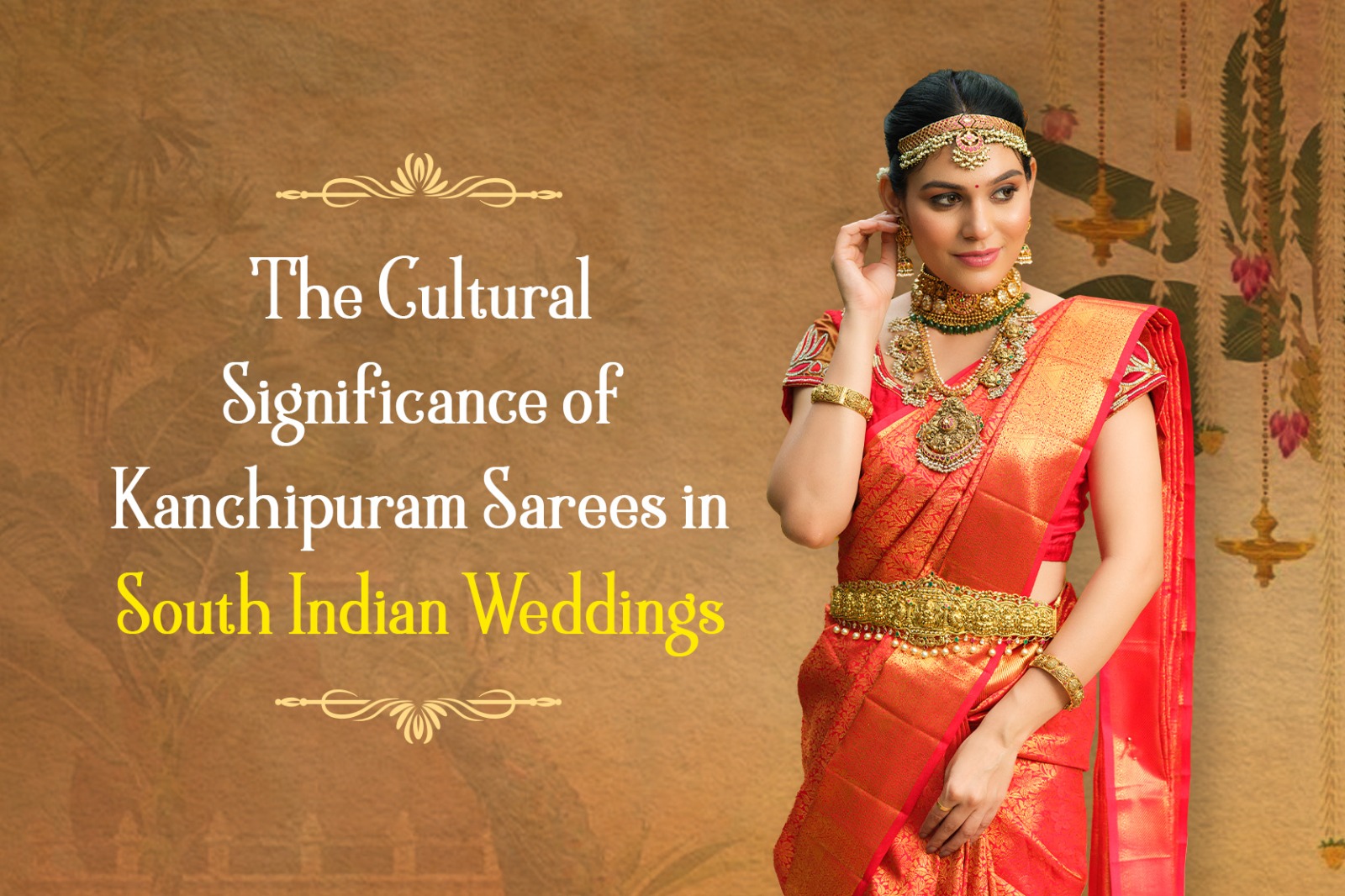
The Kanchipuram sarees hold a timeless allure and are an integral part of South Indian weddings. These exquisite pieces of art are not merely garments, they embody the rich heritage and traditions of the region. In this blog, we will explore the heritage of Kanchipuram silk, the various saree draping styles for South Indian weddings, the significance of colors, and the symbolic meaning of sarees in Indian weddings.
Heritage of Kanchipuram Silk –
The legacy of Kanchipuram silk dates back to over 400 years. Originating from the town of Kanchipuram in Tamil Nadu, these sarees are woven using pure silk threads, often adorned with intricate gold zari work. The craftsmanship involved in creating these sarees is passed down through generations, making them a symbol of tradition and cultural pride.
Kanchipuram sarees are known for their durability and vibrant colors, which are achieved through a meticulous dyeing process. The artisans use natural dyes to create stunning shades, ensuring that each saree is unique. This dedication to quality and craftsmanship has earned Kanchipuram sarees a place in the hearts of brides and women across India and beyond.
Saree Draping Styles for South Indian Weddings –
The way a saree is draped can significantly alter its appearance and impact. For South Indian weddings, there are several traditional saree draping styles that brides can choose from-
- Nivi Style: This is the most common draping style, where the saree is wrapped around the waist and pleated at the front. It allows for ease of movement and showcases the intricate designs beautifully.
- Mangalagiri Style: This style involves draping the saree in a way that emphasizes the pallu, often with elaborate pleats at the back. It’s perfect for showcasing the exquisite zari work typical of Kanchipuram sarees.
- Tamizh Style: This traditional Tamil Nadu style features a unique twist where the pallu is draped over the shoulder in a distinctive manner. It adds a regal touch to the overall look.
- Half Saree Style: Popular among younger brides, this style combines a skirt with a dupatta, allowing for playful yet elegant looks during wedding festivities.
Each draping style not only enhances the beauty of the saree but also reflects the bride’s personality and cultural roots.
Kanchipuram Sarees for Wedding Rituals
In South Indian weddings, Kanchipuram sarees play a pivotal role during various rituals. They are often worn during sacred ceremonies such as:
- Kashi Yatra: The groom’s journey to Kashi (Varanasi) symbolizes his readiness for marriage. Brides often wear vibrant Kanchipuram sarees during this ritual to signify their importance.
- Mangalya Dharanam: This is one of the most important rituals where the groom ties a sacred thread around the bride’s neck, symbolizing their union. Brides typically wear their most exquisite Kanchipuram saree during this ceremony.
- Saptapadi: The couple takes seven steps together, each representing a vow they make to each other. Brides often choose rich colored sarees for this momentous occasion, enhancing its significance.
The choice of a Kanchipuram saree during these rituals not only adds beauty but also connects brides to their cultural heritage.
Colors of Kanchipuram Sarees for Brides –
Colors hold profound significance in Indian weddings, and Kanchipuram sarees offer an array of hues that symbolize different aspects:
- Red: Traditionally associated with prosperity and fertility, red is a popular choice for brides as it signifies auspiciousness.
- Gold: Symbolizing wealth and grandeur, golden shades are often chosen by brides looking to make a statement on their special day.
- Green: Representing new beginnings and fertility, green is increasingly becoming popular among modern brides who wish to embrace tradition while adding a contemporary twist.
- Pastel Shades: In recent times, soft pastel colors have gained popularity among brides who prefer subtle elegance over boldness.
The selection of colors not only reflects personal taste but also aligns with cultural meanings associated with each shade.
Symbolic Meaning of Sarees in Indian Weddings
In Indian culture, especially during weddings, sarees carry deep symbolic meanings. They represent:
- Tradition: Wearing a saree connects brides to their ancestry and cultural roots, serving as a reminder of their heritage.
- Feminine Grace: The elegance associated with wearing a saree enhances femininity and gracefulness, making it an ideal choice for brides on their wedding day.
- Unity: The act of draping a saree symbolizes unity between families as both sides come together to celebrate love and commitment.
- Cultural Identity: Each region in India has its unique style of saree which reflects its culture. Wearing a Kanchipuram saree during weddings reinforces regional identity while celebrating diversity.
As brides prepare for their special day, choosing a Kanchipuram saree becomes not just about aesthetics but also about embracing one’s roots and celebrating timeless traditions that have been passed down through generations. Whether it’s through vibrant colors or intricate designs, Kanchipuram sarees continue to be an integral part of South Indian weddings, ensuring that every bride feels like royalty on her big day.


